Crochet is an art that grows on you, and there is never a better time than the present, to learn a new craft or skill. I learnt how to crochet more than 50 years ago, so a lot of it seems to be second nature to me. I will share with you my knowledge and expertise in the best way possible. Look out for the free crochet patterns for beginners at the end of the post.
The widespread appeal of crochet is that it is easy to do and can be interpreted in many ways. 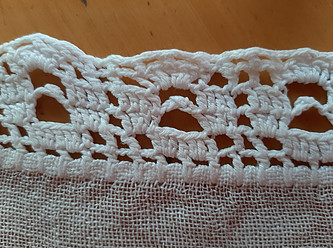 From lacy and delicate threads and patterns for doilies and tablecloths, to more robust and sturdy threads and patterns that are used for blankets and rugs, there is no limit to the possibilities.
From lacy and delicate threads and patterns for doilies and tablecloths, to more robust and sturdy threads and patterns that are used for blankets and rugs, there is no limit to the possibilities.
These instructions to learn how to crochet for beginners, are for right-handed people (sorry). My mum was left-handed so she couldn’t teach me, I had to teach myself! The affordability of materials make this an art that is accessible to all.
When you first learn how to crochet, there will be a few basic stitches that you will use frequently. Basic stitches can be used to create many projects, and as you learn and practice more, you can move on to more advanced stitches.
Choosing your yarn and hook
A common question that I hear is “Which yarn do you use when?” 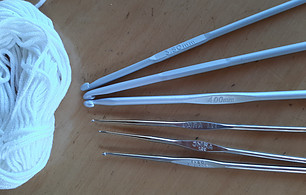
- Fine mercerized thread is used for delicate designs like doilies, tablecloths and edgings on table linen and bed linen.
- Yarn in organic cotton, wool, linen and other fibers are good for baby clothing, blankets, tops and sweaters, ponchos and other fashion products.
- Rug yarn is best for rugs, potholders and bags.
Crochet hooks, as with knitting needles, are available in a variety of sizes and materials ranging from aluminium, to steel, bamboo and wood and also plastic. The size of the hook to be used depends on the pattern and the thickness of the yarn. The finer and thinner the thread, the smaller the hook. Knitpicks has a big range of hooks and yarns for any project.
Getting Started – make a basic loop 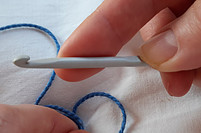
Hold the hook as if you are holding a knife. (some people prefer holding it as if you are holding a pen or pencil.
Grasp the thread near the end between the thumb and the forefinger.
The way to start is with a simple slip knot. Hold the yarn near the end and make a loop by lapping the long end over the short end. Insert the hook through the loop and while holding both ends, pull the hook through.
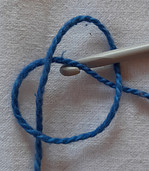
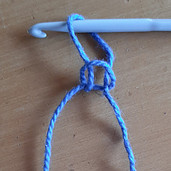
Pull both ends of the yarn in opposite directions to close the loop.
The left hand basically controls the tension through the loops through the fingers. It should move easily and freely, so don’t try to hang onto the thread or clutch it too tightly. The motion of the hook in the right hand to the thread in the left hand, should be smooth and easy. Many beginners tend to hang onto the thread too tightly or have it too loosely.
The most common mistake of people learning to crochet, is to crochet too loosely or too tightly. So relax and enjoy it, that way the thread in your left hand will be smooth and easy to move along.
Notes and Tips: 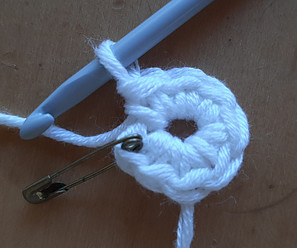
- The norm in crochet is to pick up both loops or threads of each stitch, unless otherwise specified. A different effect is created when only the back thread is picked up.
- Always keep your thumb and forefinger of your left hand close to the stitch on which you are working.
- Practice making chain stitches until they are even in size and tension.
- When you are learning a new stitch, make a small swatch or practice piece to make sure you are comfortable with what you have learnt.
- Mark the start of each round with a safety pin in the first stitch of the round if it will help you to recognize the start of a round.
- Thread over is the same as yarn over. Here I use yarn over.
Here you can see Amazon’s choice for hooks and yarns.
Abbreviations 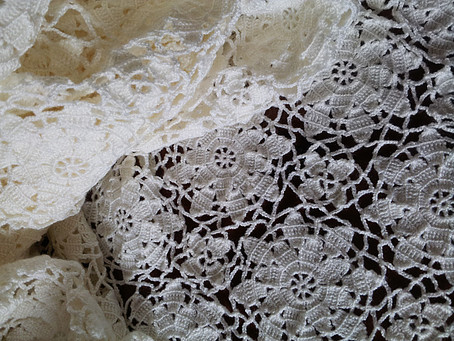
- ch = chain stitch
- dc = double crochet
- dec = decrease
- d tr = double treble
- h dc = half double crochet
- incl = inclusive
- inc = increase
- rnd = round
- sc = single crochet
- sl st = slip stitch
- sp = space
- st and sts = stitch and stitches
- tr = treble
- tr tr = triple treble
One would often find * in instructions.
- Repeat from * across – means you follow the directions from the first * to the last * across the row.
- Repeat from * around – means you follow directions from the first * to the last * around the round or circle.
- Repeat from * followed by a number eg. 4 – means you follow the directions from the first * and repeat for the amount of times specified.
Chain stitch
Chain stitch is the first stitch that you are taught when you learn how crochet for beginners. To make a chain stitch: 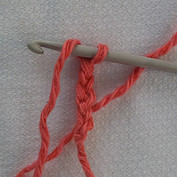
- Pass the hook under the thread and catch the thread with the hook. This is called “yarn over” or “thread over”.
- Draw the thread through the loop on the hook to make one stitch or chain.
Repeat these steps of passing the hook under the thread and hooking it through, until you have as many chain stitches as you need or what your pattern calls for. One loop will always remain on the hook.
Slip Stitch (sc)
Slip stitch is only used when an invisible stitch is required. When you see in direction that you must “join”, a slip stitch is used. 
- Insert the hook from the front through both loops of the chain.
- Yarn over and in one movement draw the thread through the chain and the loop on the hook.
One loop remains on the hook and that is a slip stitch.
The four most commonly used basic stitches are single crochet, half double crochet, double crochet and treble crochet. These are all just a variation of each other, with the height of the stitch increasing from single crochet to treble crochet. Single, double and treble crochet just increase the amount of times you thread over, so that the length of each stitch is a bit more.
Half double crochet is halfway in height between single crochet and double crochet and is worked slightly differently. .
Single Crochet (sc)
Single crochet is the second basic stitch that you will come across when you learn how to crochet for beginners. To start, make a chain of 20 stitches to practice.
- Insert the hook from the front, into the second chain from the hook.
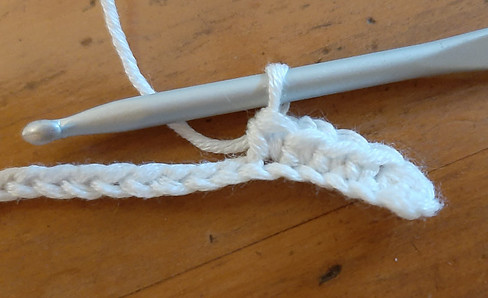
- Catch the thread with the hook (this is known as yarn over or thread over) and draw it through. There are now 2 loops on the hook.
- Yarn over and draw through 2 loops, which leaves 1 loop remaining on the hook. You have completed 1 single crochet.
For the next single crochet, insert the hook into the next chain stitch, and repeat steps 2 and 3.
Repeat these until you have made a single crochet (sc) in each chain stitch (ch). At the end of the row, chain 1, which will enable you to turn the work.
Second Row of Single Crochet – turn the work that the reverse side is facing you. 
- Insert the hook, from the front, under both threads of the first stitch (which is the last stitch on the previous row).
- Catch the thread with the hook (so yarn over) and draw it through so that you now have 2 loops on the hook.
- Yarn over and draw through 2 loops, which leaves 1 loop remaining on the hook.
Repeat these steps until you have a single crochet in each stitch and make a chain stitch at the end or the row.
To break off at the end of the row: don’t make a chain stitch at the end of the row. Instead, cut the yarn and pull it through the remaining stitch.
Half Double Crochet (h dc) 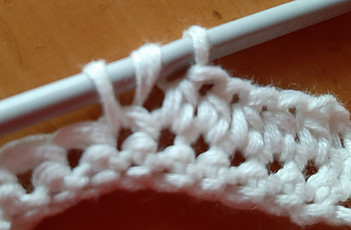
For practice make a chain of 20 stitches.
- Yarn over and insert hook from the front under both loops of the 3rd ch from the hook.
- Yarn over hook and pull loop through chain so you have 3 loops on the hook.
- Yarn over and draw through all loops on the hook.
- One loop remains on the hook.
A half double crochet is completed.
Make 2 chain stitches at the end of the row to turn for the second and subsequent rows.
Double Crochet (dc) 
Double crochet is another basic stitch that you will use a lot when you learn how to crochet for beginners. Make a chain of 20 stitches to practice:
- yarn over and insert hook from the front under both loops of the 4th ch from the hook.
- Yarn over hook and pull loop through chain so you have 3 loops on the hook.
- Yarn over and draw through 2 loops on the hook, 2 loops remain on the hook.
- Yarn over again and draw through remaining 2 loops.
- One loop remains on the hook.
A double crochet is completed.
Make 3 chain stitches at the end of the row to turn for the second and subsequent rows. This is a common basic stitch to be used in crochet patterns for free.
Treble Crochet (tr)
To confuse matters, in the UK this is a treble crochet, while in USA it is a double crochet. 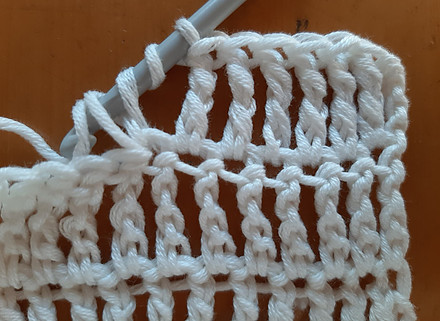
Make a chain of 20 stitches to practice:
- thread over twice and insert hook from the front under both loops of the 5th ch from the hook.
- thread over hook and pull loop through chain so you have 4 loops on the hook.
- thread over and draw through 2 loops on the hook, 3 loops remain on the hook.
- thread over again and draw through 2 loops on the hook, 2 loops remain on the hook.
- thread over again and draw through remaining 2 loops.
- One loop remains on the hook.
A treble crochet is completed. Make 4 chain stitches at the end of the row to turn for the second and subsequent rows. Treble crochet stitches are longer stitches and creates more flowing fabrics like scarves and garments.
Double Treble Crochet (d tr) 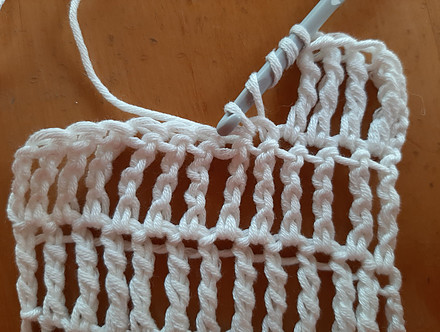
Make a chain of 20 stitches to practice:
- yarn over 3 times and insert hook from the front under both loops of the 6th ch from the hook.
- Yarn over hook and pull loop through chain so you have 5 loops on the hook.
- Yarn over and draw through 2 loops on the hook, 4 loops remain on the hook.
- Yarn over again and draw through 2 loops on the hook, 3 loops remain on the hook.
- Yarn over again and draw through 2 loops on the hook, 2 loops remain on the hook.
- Yarn over again and draw through remaining 2 loops.
- One loop remains on the hook.
A double treble crochet is completed.
The same idea of adding another yarn over can be used to create taller stitches. So a triple treble crochet will have 4 yarn over to start and a quadruple treble is with 5 yarn over, and so forth.
Turning your work
In crochet, a certain number of chain stitches are added at the end of each row, to bring the work into position for the next row. The number of stitches that you require in the turning chain, depends on the stitch that you will continue with in the following row. These are the amount of chain stitches that you require, depending on the stitch in the following row:
- for single crochet (sc) – chain 1 to turn
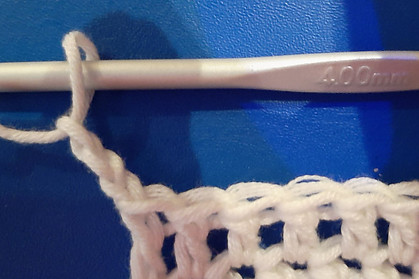
- half double crochet (h dc) – chain 2 to turn
- double crochet (dc) – chain 3 to turn
- treble (tr) – chain 4 to turn
- double treble (d tr) – chain 5 to turn
- triple treble (tr tr) – chain 6 to turn)
Remember that you always start with the second or subsequent stitch in a row, because the turning chain counts as the first stitch. Two common mistakes that people make when they learn how to crochet, are these:
- to start in the 1st stitch,
- and to forget the last stitch.
It is sometimes difficult to see the final stitch in a row, specially with single crochet, so don’t forget to add the last stitch. Count at the end of the row to make sure that you still have the same required amount of stitches. If the rows are very long, you might benefit from using a stitch counter to help you keep track of the stitches in a row.
Additional Tutorials
Go here if you want to learn how to crochet in rounds or circles and to make squares and rectangles, and it includes crochet patterns for free.
Look out for my post on Advanced Crochet stitches, where you can learn more, or explore textured crochet stitches to add dimension to your projects.
This is an alternative way of starting and one that I have personally been using.
Insert the crochet hook underneath the thread, from the left to the right, and turn the hook to form a cross.

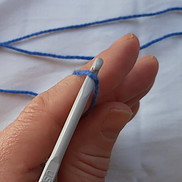
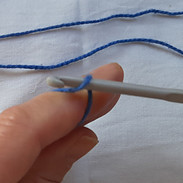
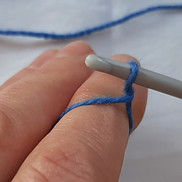
Put the hook under the thread and pull it through to form the first stitch.

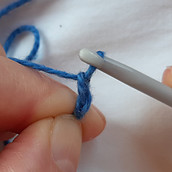
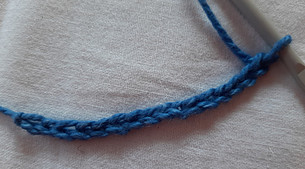
I hope this guide will help you to learn how to crochet for beginners and master the basic stitches, but if you do have any questions or suggestions, please leave them below and I will get back to you.

Great article Line! I would say that its a perfect beginner’s training material. My mom is extremely good at crochet and equally bad at explaining how it’s done. I am always fascinated whenever I see someone doing this because it’s amazing to watch a complete piece of clothing to be prepared out of a single roll of thread! Amazing. Several times I asked her to teach me how she does it. And, she is always like it’s so easy just do it like this, and the rest of the part is done itself. As a reply, I always tell her that nothing happens by itself it is you doing it.
After reading your post today I can understand what she does in more detail, maybe I could do it this time.
Thanks,
Vinayak
Hi Vinayak, You are welcome and I hope it will help you to learn to crochet, even without your mom then. Liné
Aww, I found your site while I was searching for the meaning of some abbreviations. After I found a directory you prepared I decided to scroll around your site and I see you have great content here. I’m learning how to crochet and I have been making this basic loop over and over today. You picked me up just where I am. Thank you!
Awesome to hear that this post will help you.
WOW! I am not a beginner crocheting person, but I now know I knew nothing at all. I love the safety pin as I always had to guess where the actual starting loop was in my work. I am now well versed because of this article what all the abbreviations are. I never knew there was a 1/2 double crochet; thank you for that! Your article on crocheting is now my go-to as you have covered so many stitches and it is very clear to understand. I am grateful for your knowledge with much love and light!
I am so pleased to hear that you have found my post helpful and have learnt something new. Please do let me know if you need help with anything else.
This topic on crochet is great for beginners and for those who want to brush up on the skill. You provide a very thorough approach to learning how to crochet. This step by step approach will really help the novice learn the art of crochet. You give very detailed information which will make the person wanting to learn this art feel as though they can really accomplish their goal. This is a great instructional and informative website.
Thank you for your kind comments Patricia. Crochet is a great mindful craft and much easier to learn that many people realise. I do hope that these basic stitches will beginners, but also anyone who want to brush up on their skills.
Hello there,thanks for sharing this awesome article I know it would be of great help to the public as it has been of help to me… I have been into this for a very long time and one place that is very important that most beginers fail to understand on time I the crochet chain…. A crochet project begins with a chain stitch, usually abbreviated as ch.To get this right practice crocheting a chain for about 10 to 15 minutes a day until you are able to hold the yarn so that it is not too loose or too tight.thanks once more.
Regards,
David.
Hi David, when you learn how to crochet it is a good idea to make a practice piece to try new stitches. It is not important for how long you do it, but rather when you feel comforatble and happy with your results.
Interesting post. My wife is a lifelong crocheter (is that even a word?), she loves to create blankets, sweaters, hats… usually for children. Personally I hate the explosion of yarn she leaves anywhere she’s crocheting (typically in the den where we watch TV). I do like the more delicate stitches and yarn that you’ve used in the images on your post. I will share this wit the wife and hopefully she can get some value from this.
Thanks for posting
Thanks Bob, I hope your wife will find it useful
Hello Liné, as far as I am concern this is one thing that many people needs to learn to do for the skill is very nice as an extra talent. Growing up, my mum would spend time making different designs and use it for various purposes in the house and it’s really nice seeing it. My wife too is good in it, but all I can do is the single crochet and i hope to develop myself more in it. If you are good in it, you can make some money and also save money from doing it.
Hi Benson, crochet is a craft that you can use to make money by selling your handmade items, and you can save money by making items for yourself. It is also a craft that relaxed your mind and body.
These are one of the skills that I gave been hungering to learn for a very long time. And now that there is a lockdown, it has given me the opportunity to give it a try. I am starting with your post here before going in to watch some YouTube videos as well. You seem to know so many ways to crochet and many different types of crocheting as well. That’s a very good thing. I have learnt really well from here.
Thank you Riley and I am sure you will enjoy to learn how to crochet.
Wow! This has covered virtually everything and it seems massive to take in for me. I just started learning crotcheting and seeing this here makes me feel like I dont know anything yet at all. Though I am taking an online class but it actually feels good getting to know more here and km delighted you have shared here. Thank you so much and thumbs up
Thanks Ella and please do let me know if you need help with anything. Crochet is a great craft and I am sure you will enjoy to learn how to crochet.